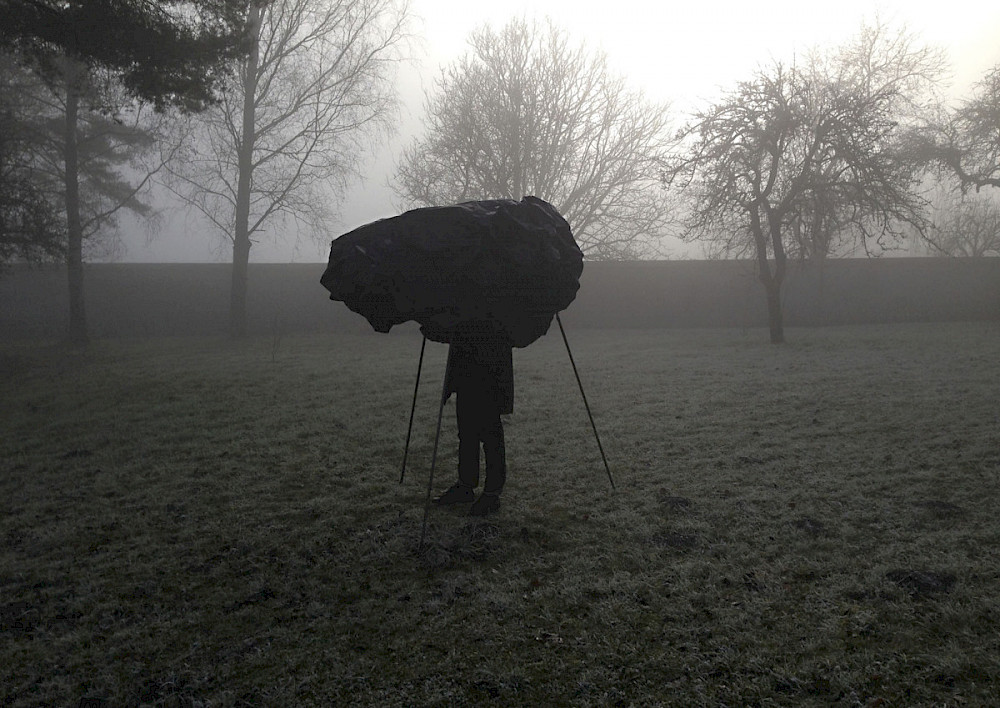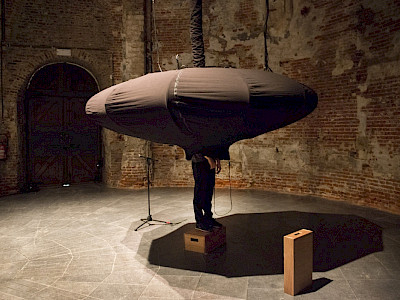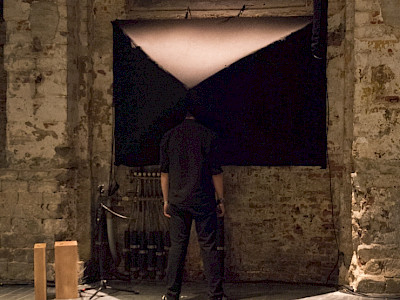18 — 21.05, 23 — 27.05.2017
Begüm Erciyas Brussels / Berlin
Voicing Pieces
performance
English | ⧖ ±30min | € 14 / € 10 | Book your time-slot at the box office
Get talking! In Voicing Pieces, Begüm Erciyas explores the political and poetic power of the act of speaking. In the intimacy of a soundproof booth, we discover a script whose words have to be deciphered out loud. Alone with the text, we become the audience of our own performance. The simple act of reading while hearing yourself speak is turned into a theatrical and choreographic experience. Our voices become detached from our bodies. It becomes a tool of action, a surprise, a show. As if endowed with autonomous will, it plays with us as much as we play with it. Don’t our voices always seem strange and inauthentic to us? Voicing Pieces invites us to discover and accept the stranger in us. A liberating experience.
We speak in between
Voicing Pieces is a choreography for one’s own voice. Literally. Because while you’re reading a script in a dark cabin, you are the only listener; your experience is being dragged through very different perspectives. Physically. Due to the structure of the script and various minimal, technical interventions, you are alienated from your voice and become your own viewer and performer at the same time. Along the way you will discover in your own voice – one of the most intimate parts of your identity – more and more facets of something that you are not. What begins as an innocent soundcheck suddenly turns into cues from a director, seemingly the author’s lines of thought, revelations of a main character or echoes of collective role patterns from movies or pop songs. In that the script takes a walk with your voice but it is you who brings those characters to life, a game is created between playing and being played. Because through the different scenes you are not only discovering how much ambient sound or atmospheric music can determine the score. Intonation and tempo alone can summon very different characters in the same script.
Then who is speaking when I speak? In Voicing Pieces, your individual speaking voice is disconnected from a personal intention or fixed identity and is taken over by ‘strange voices’. But it’s through the room for manoeuvre in the interpretation – it’s still your voice – that you indirectly express something personal. At the same time, as a performer, you infiltrate what we do not usually attribute to the individual voice: you also interpret counter-voices that sometimes ascend into the ambient sound. It is as if the locus of our personality is constantly shifting. The ‘I’ disintegrates into all that it is not, only taking shape through your personal relationship with those elements. That’s the magic of the double role you are assigned as a participant. Like a spell or mantra, as soon as it is pronounced, the script becomes a choreography of the relationships that determine us, in which you are the performer as well as the choreographer. Literally, the one who determines how the choir of different voices relate to each other.
Being is performative and temporary. In a kind of tournament with yourself, you are reminded that every identity or voice is a process that can only take place by dealing with what is not part of the self. Our speaking in everyday life is also influenced by external factors such as our environment, education, cultural role models, and mother tongue. In that sense, the voice of another resounds in every voice. But even though each identity starts with a cultural or social regulation, it forms and transforms itself between the lines and is merely shaped by the execution. It is the degree of lucidity with which we interpret the voices in and around us, and the echoes, that determines whether they stand in the way of our individuality or just become a soundtrack for it. Voicing Pieces is an invitation to that game.
Marnix Rummens, May 2017
Voicing Pieces
She, the reader, is always a beginner, initiating something. That’s why reading is so seductive: a delicate conception and an initiation of change, a fragile start, which is also a practice of liberation. This quality of reading appeared so clearly the moment I placed the upper part of my body into the mushroom-like structure in the Voicing Pieces performance and opened the first page of the huge book, which was waiting there for me to read out loud: with the first word, the reading opened itself into an unstoppable, overflowing, almost overwhelming sequence of events. My voice tested itself, checked its colour and intensity, adjusting its frequency and the ways it was forming the consonants; but at the same time, it was also given back to me, to the reader. The text started to run through my body with its various shades, repetitions, and echoes, coming closer and then receding, until my voice and the text finally uttered the opening of the performance piece and I read aloud in the isolation of the mushroom: “I’m speaking the beginning. I’m starting this sentence without knowing where it is going.”
Isn’t this exactly what reading is? We never know when we start reading where we are going, where the voice of the read words (be it silent or loud) is taking us. Lisa Robertson, a poet whose delicate essay on reading echoes strongly with my own viewing of this performance, described that quality of the unknown in reading in a wonderful way: “As I read, my self-consciousness is not only suspended but it is temporarily abolished by the vertigo of another’s language. I’m simply a conduit, its gutter. This is a pleasure.” And pleasure is exactly what is continuously experienced in the Voicing Pieces performance, in our playful reading of the text, waiting for us in the three mushroom-like stations. There is a sheer pleasure in the ways of reading and loudly voicing words into the unknown, towards something that has yet to come, and our act of reading is establishing the very event, the very performance we are in. We are playing with words, inclinations, rhythms, repetitions, echoes, sounds, continuously voicing and amplifying these various non-semiotic dimensions of language that give it its affective and emotional qualities; the way in which language touches us, how it is made, how it comes together, is similar to how poetry affects us. This performance is as much an exploration of the voice as it is an exploration of reading, an exploration of the complex relationship between the reading of the written word, its typography, form, position on the page, and dependency on voice; its sensual, vocal, and auditory dimension. We are always reading at the paradoxical limit between outside and inside; the reading belongs to this strangely combined notion of extimacy: there would be no reading if something foreign could not take place in the most intimate parts of us. Maybe that’s why, when we are reading, it seems as if we have our heads in the clouds or, in this particular performance, in the cloud-like mushroom, which looks like a cave from the inside. Inside we are isolated, alone, but at the same time we are in the obscene vicinity of our voice, which returns to us through a multiplicity of voices, shaking the ways we inhabit our bodies and our lonely reading rooms. This can be linked to the very politics of reading, which hangs somewhere in-between the written structure on the page and the multiplicity of the reading voices originating from it, where through the extreme singularity of the reading process we also become participants with something in common. In this performance we trigger the very performance we are in, through the singular and isolated gesture of reading aloud, while at the very moment we actively take over the reading we simultaneously become a vehicle of the events that overflow in their intensity and proximity onto our body and the text.
The reading voice then moves between passivity and the will, between ourselves that are giving us to the performance and the ways that we are working on it, actively composing and performing it. When we open our mouth to speak the text, the voice not only liberates itself from the text, but also from the body that utters it; however, this liberation is only possible if we are also faithful to the text, to the materiality of the written book, to the pages that are there to be read. In the Voicing Pieces performance another paradoxical feature of reading becomes evident. It seems that reading is a sheer immaterial force, a force of thinking, which can, through its strength, change the ways we reside in our bodies. But reading is also a labour, a bodily effort; true to the book, it holds itself to it, it works through its pages. This paradoxical relationship between the materiality and immateriality of reading is disclosed in the performance through the movement of the voice, which can be heard only if it’s dependent on the text and simultaneously independent from it. The voice is travelling through the different kinaesthetic and embodied experiences of reading, playing with our senses and affecting us, while we consciously play with our own voice, joyfully playing with reading on the very brink of the abyss in which we could become lost.
This actually happened to me, the reader, towards the end of the performance, when I visited the third cloud-like mushroom where the pages were now displayed all around me. The mushroom was hanging in the air over my head and inside of it I was reading the text about writing and being drunk. My voice came back with a delay, auditorily manipulated, such that it was decelerating and losing rhythmical balance; it was the voice of a drunken person. Once I had to hold onto myself in order not to lose my balance, so independent was my reading voice. But the structure that contained me was also moving, and the only thing that would keep me on my feet and restore my balance was to continue reading. “Now I’m speaking the end of the piece that will be the piece echoing itself.” This is reading. “It’s a timely dallying and surge among a cluster of minute identifications. I prefer to become foreign and unknowable to myself in accordance with reading’s audacity.” (Lisa Robertson).
Bojana Kunst, May 2017
Concept
Begüm Erciyas
Realisation
Matthias Meppelink and Begüm Erciyas
Dramaturgy
Marnix Rummens
Text
Matthias Meppelink, Begüm Erciyas, Jacob Wren
Live operation
Julia Krause, Niels Bovri, Begüm Erciyas, Marc Melià, Eric Desjeux
Host
Lili M. Rampre, Jessica Batut
Set realization
Tim Vanhentenryk, Lena Buchwald, Barbara Greiner
Artistic collaboration
Jean-Baptiste Veyret-Logerias
Production management & PR
Barbara Greiner
Thanks to
Christophe Albertijn, Emi Kodama, Matthew Goulish, Ludo Engels, Jesse Jansens, Juan Gabriel Harcha, Philippe Quesne, Andrea Kränzlin
Presentation
Kunstenfestivaldesarts, Les Brigittines
Production
Begüm Erciyas, Platform 0090
Co-production
wpZimmer (Antwerp), STUK (Leuven), Tanzfabrik Berlin/Tanznacht Berlin
Research support/residency
Kunstencentrum BUDA (Kortrijk), Q-O2 Workspace for experimental music and sound art (Brussels), FrankfurtLAB, Tanzrecherche NRW, Goethe-Institut Villa Kamogawa
Supported by
Hauptstadtkulturfonds Berlin







